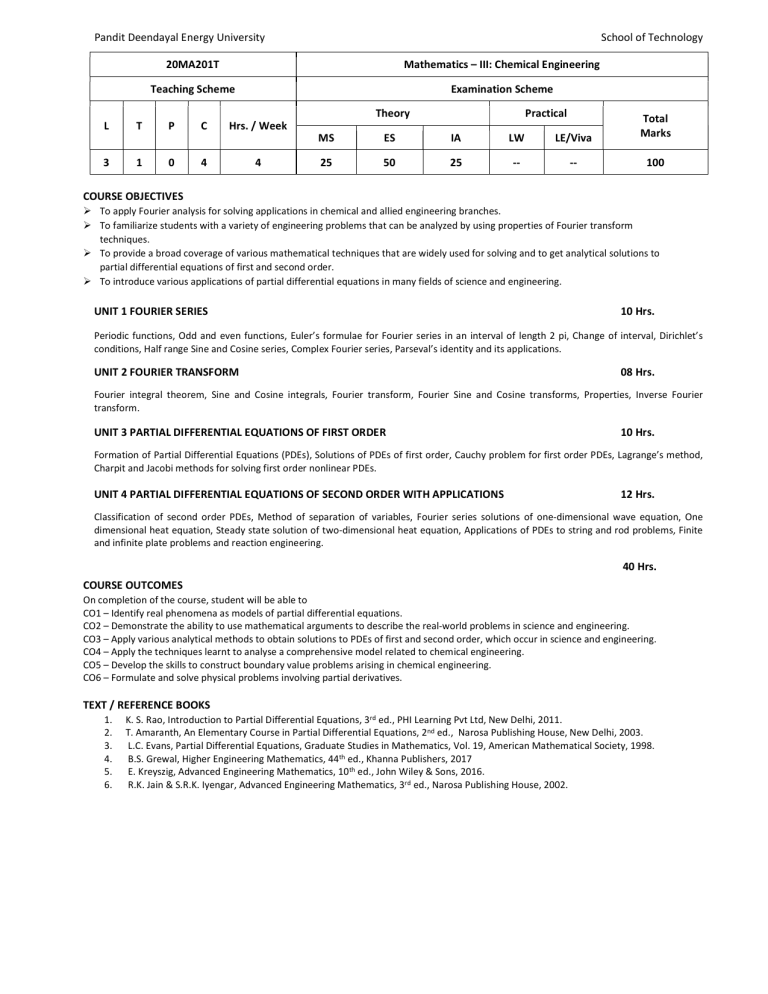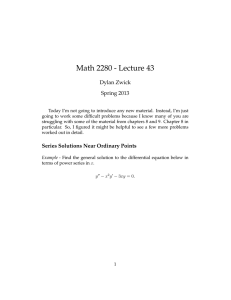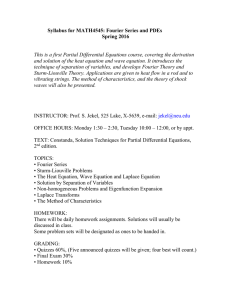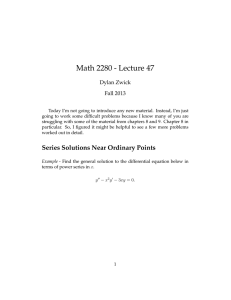
Pandit Deendayal Energy University School of Technology 20MA201T Mathematics – III: Chemical Engineering Teaching Scheme Examination Scheme L T P C Hrs. / Week 3 1 0 4 4 Theory Practical MS ES IA LW LE/Viva Total Marks 25 50 25 -- -- 100 COURSE OBJECTIVES To apply Fourier analysis for solving applications in chemical and allied engineering branches. To familiarize students with a variety of engineering problems that can be analyzed by using properties of Fourier transform techniques. To provide a broad coverage of various mathematical techniques that are widely used for solving and to get analytical solutions to partial differential equations of first and second order. To introduce various applications of partial differential equations in many fields of science and engineering. UNIT 1 FOURIER SERIES 10 Hrs. Periodic functions, Odd and even functions, Euler’s formulae for Fourier series in an interval of length 2 pi, Change of interval, Dirichlet’s conditions, Half range Sine and Cosine series, Complex Fourier series, Parseval’s identity and its applications. UNIT 2 FOURIER TRANSFORM 08 Hrs. Fourier integral theorem, Sine and Cosine integrals, Fourier transform, Fourier Sine and Cosine transforms, Properties, Inverse Fourier transform. UNIT 3 PARTIAL DIFFERENTIAL EQUATIONS OF FIRST ORDER 10 Hrs. Formation of Partial Differential Equations (PDEs), Solutions of PDEs of first order, Cauchy problem for first order PDEs, Lagrange’s method, Charpit and Jacobi methods for solving first order nonlinear PDEs. UNIT 4 PARTIAL DIFFERENTIAL EQUATIONS OF SECOND ORDER WITH APPLICATIONS 12 Hrs. Classification of second order PDEs, Method of separation of variables, Fourier series solutions of one-dimensional wave equation, One dimensional heat equation, Steady state solution of two-dimensional heat equation, Applications of PDEs to string and rod problems, Finite and infinite plate problems and reaction engineering. 40 Hrs. COURSE OUTCOMES On completion of the course, student will be able to CO1 – Identify real phenomena as models of partial differential equations. CO2 – Demonstrate the ability to use mathematical arguments to describe the real-world problems in science and engineering. CO3 – Apply various analytical methods to obtain solutions to PDEs of first and second order, which occur in science and engineering. CO4 – Apply the techniques learnt to analyse a comprehensive model related to chemical engineering. CO5 – Develop the skills to construct boundary value problems arising in chemical engineering. CO6 – Formulate and solve physical problems involving partial derivatives. TEXT / REFERENCE BOOKS 1. 2. 3. 4. 5. 6. K. S. Rao, Introduction to Partial Differential Equations, 3rd ed., PHI Learning Pvt Ltd, New Delhi, 2011. T. Amaranth, An Elementary Course in Partial Differential Equations, 2nd ed., Narosa Publishing House, New Delhi, 2003. L.C. Evans, Partial Differential Equations, Graduate Studies in Mathematics, Vol. 19, American Mathematical Society, 1998. B.S. Grewal, Higher Engineering Mathematics, 44th ed., Khanna Publishers, 2017 E. Kreyszig, Advanced Engineering Mathematics, 10th ed., John Wiley & Sons, 2016. R.K. Jain & S.R.K. Iyengar, Advanced Engineering Mathematics, 3rd ed., Narosa Publishing House, 2002.


